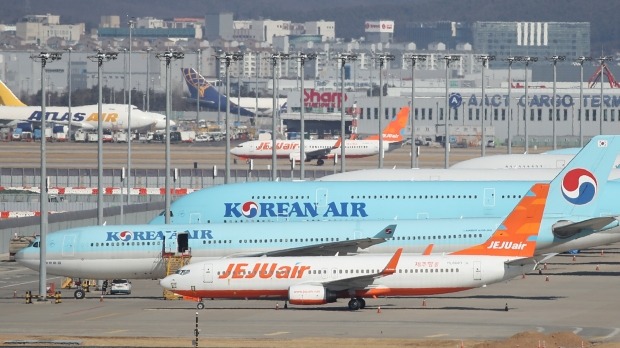
Photo = Yonhap News
In the aftermath of the novel coronavirus infection (Corona 19), domestic airlines are continuing to reduce their fleet this year following last year. It aims to minimize fixed expenses by reducing the number of aircraft in possession. This is because, in a situation where demand for international passengers is not recovering, it is possible to last longer only by reducing their size. Analysts say that the’economy of scale’, which makes profits by growing in size, is not working properly in the aviation industry due to Corona 19.
One year lease debt alone is 141.4 billion won

According to the aviation industry on the 1st, domestic airlines have decided to return a large number of aircraft whose rental period expires this year and postpone plans to introduce new aircraft. The start was opened by Jeju Air, the nation’s largest low-cost airline (LCC). Jeju Air CEO Kim Lee-bae said on the 25th of last month, “We plan to return a significant number of equipment that expires in the rental period in consideration of the speed of recovery in the shrinking market and the fixed costs of maintaining air mass.” Jeju Air plans to reduce its number of aircraft from 44 last year to 38 this year by returning 6 aircraft this year. Jin Air also ended the lease contract for two Boeing 737-800s in January and decided to return two more of the same model last month.
Airlines buy or lease aircraft. LCCs mainly rent aircraft because the price per unit is at least 100 billion won. The problem is that the more aircraft you borrow, the higher your lease. As of the third quarter of last year, the lease debt that Jeju Air had to pay off within one year amounted to 141.4 billion won. During the same period, the lease interest cost alone was 15 billion won.
Korean Air and Asiana Airlines, which have relatively few leased aircraft, are planning to flexibly proceed with this year’s fleet operation plan according to the Corona 19 situation. However, it is observed that most aircraft that have expired are likely to be returned. Korean Air reduced its number of aircraft from 169 in 2019 to 159 in the aftermath of Corona 19 last year. During the same period, Asiana also returned two.
The aviation industry does not work with’economy of scale’
The aviation industry is complaining that the’economy of scale’ does not work in the Corona 19 situation. It is explained that the more airlines that have more aircraft due to a sharp drop in passengers, the greater the loss due to fixed expenses such as cycle fees (aircraft parking fees) and lease fees. Even in the low-cost competition for catching domestic passengers, small airlines with low fleet maintenance costs are advantageous.
It is for this reason that there are pessimistic observations that it will be difficult to withstand the unified LCC, which plans to start anew by increasing the scale in accordance with the integration of Korean Air and Asiana Airlines. Unlike Korean Air and Asiana Airlines, which are focusing on cargo business, LCC relies on passenger demand, which inevitably results in large losses every quarter.
According to the Ministry of Land, Infrastructure and Transport, the number of domestic air passengers last year was 39.4 million, a 68.1% decrease from the previous year (12.37 million). The number of passengers has fallen below 40 million in more than 20 years since 1998 (3.31 million) and 1999 (37.89 million), just after the financial crisis. In particular, the number of international passengers last year was only 14.24 million, a sharp decline of 84.2% from the previous year.
It is reported that the government and Korea Development Bank are considering additional policy financing support for airlines. LCCs believe that their cash holdings will run out after the first half of this year if the current situation continues. The government is considering supporting policy funds in parallel with self-rescue measures, such as capital increase and contributions to large shareholders.
Reporter Kang Kyung-min [email protected]
Ⓒ Hankyung.com prohibits unauthorized reproduction and redistribution
